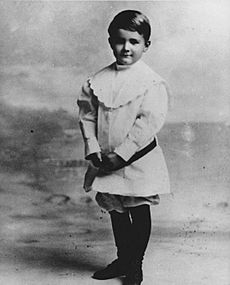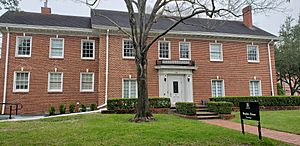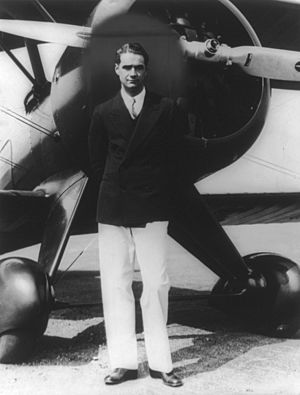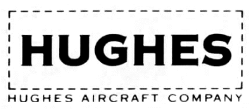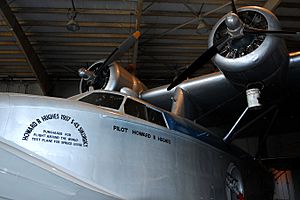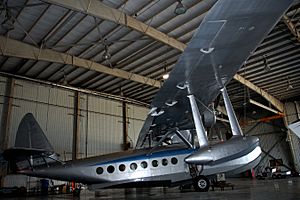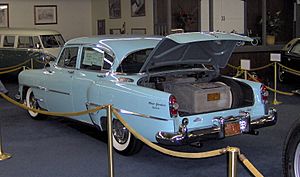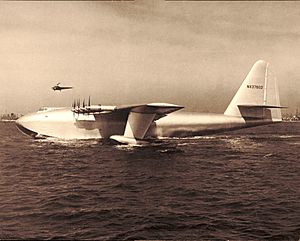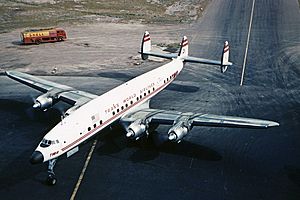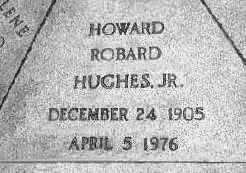Howard Hughes facts for kids
Quick facts for kids
Howard Hughes
|
|
|---|---|
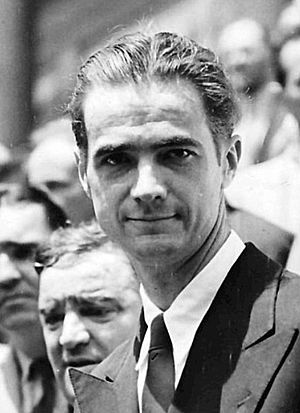
Hughes in 1938
|
|
| Born |
Howard Robard Hughes Jr.
December 24, 1905 Houston, Texas, U.S.
|
| Died | April 5, 1976 (aged 70) enroute via air from Mexico to Houston, Texas, U.S.
|
| Resting place | Glenwood Cemetery |
| Alma mater | Caltech (attended for math and aeronautical engineering courses) Rice University (dropped out in 1924) |
| Occupation | Chairman and CEO of Summa Corporation Founder of The Howard Hughes Corporation Founder of the Hughes Aircraft Company Founder and benefactor of the Howard Hughes Medical Institute Owner of Hughes Airwest Airlines |
| Years active | 1926–1976 |
| Board member of | Hughes Aircraft Company Howard Hughes Medical Institute |
| Spouse(s) |
Ella Botts Rice
(m. 1925; div. 1929) |
| Parent(s) | Howard R. Hughes Sr. (father) |
| Relatives | John Gano (ancestor) Rupert Hughes (uncle) |
| Awards | Harmon Trophy (1936, 1938) Collier Trophy (1938) Congressional Gold Medal (1939) Octave Chanute Award (1940) National Aviation Hall of Fame (1973) |
| Aviation career | |
| Famous flights | Hughes H-1 Racer, Transcontinental airspeed record from Los Angeles to Newark NJ (1937), round the world airspeed record (1938) |
| Signature | |
Howard Robard Hughes Jr. (December 24, 1905 – April 5, 1976) was an American businessman, amazing pilot, engineer, movie producer, and generous giver. During his life, he was known as one of the most powerful and richest people in the world. He first became famous as a movie producer. Then, he became a very important person in the aviation (airplane) industry. Later in his life, he was known for being a bit unusual and living a very private life. This was partly because of a condition called OCD, pain from a bad plane crash, and losing his hearing.
As a movie boss, Hughes became famous in Hollywood starting in the late 1920s. He made big and often talked-about movies like The Racket (1928), Hell's Angels (1930), and Scarface (1932). Later, in 1948, he bought the RKO Pictures film studio. RKO was one of the biggest studios during Hollywood's Golden Age. However, the company had problems under his control and eventually closed in 1957.
Because he loved aviation and aerospace travel, Hughes started the Hughes Aircraft Company in 1932. He hired many engineers, designers, and people who worked on defense projects. He spent the rest of the 1930s and much of the 1940s setting many world air speed records. He also built the Hughes H-1 Racer (1935) and the H-4 Hercules (called the Spruce Goose, 1947). The Spruce Goose was the largest flying boat ever built. It had the longest wingspan of any aircraft from when it was built until 2019. He bought and grew Trans World Airlines (TWA) and later bought Air West, renaming it Hughes Airwest. Hughes won the Harmon Trophy twice (1936 and 1938), the Collier Trophy (1938), and the Congressional Gold Medal (1939). All these awards were for his amazing work in aviation during the 1930s. He was put into the National Aviation Hall of Fame in 1973. In 2013, Flying magazine listed him as one of the 51 Heroes of Aviation, at number 25.
In his last years, Hughes made his financial empire even bigger. He bought several large businesses in Las Vegas, like land, hotels, casinos, and media companies. At that time, he was known as one of the most powerful men in Nevada. Many people say he helped turn Las Vegas into a more fancy, modern city. After years of health problems, Hughes died in 1976. His work is continued through the Howard Hughes Medical Institute and the Howard Hughes Corporation.
Contents
Early Life and Family
Howard Robard Hughes Jr. was the son of Allene Stone Gano (1883–1922) and Howard R. Hughes Sr. (1869–1924). His father was a successful inventor and businessman from Missouri. The Hughes family had English, Welsh, and some French roots. Howard was a descendant of John Gano, a minister who some say baptized George Washington.
Hughes Sr. invented a special two-cone roller bit in 1909. This invention made it possible to drill for oil in places that were too hard to reach before. Howard's father made a smart decision to make money from his invention. Instead of selling the bits, he leased them out. He also got several early patents and started the Hughes Tool Company in 1909.
Howard Hughes's uncle was Rupert Hughes, a famous writer and film director.
Records show that Hughes was born on December 24, 1905, in Harris County, Texas. However, his baptism record from October 7, 1906, lists his birth date as September 24, 1905.
From a young age, Howard Jr. loved science and technology. He was very good at engineering. When he was 11, he built Houston's first "wireless" radio transmitter. He became one of the first licensed ham-radio operators in Houston. At 12, a local newspaper took his picture. They said he was the first boy in Houston to have a "motorized" bicycle, which he built from parts of his father's steam engine. He liked math, flying, and mechanics in school. He had his first flying lesson at 14.
Hughes went to Caltech for math and aeronautical engineering classes. The house where Hughes lived as a teenager in Houston is still there. It is now called Hughes House on the grounds of the University of St. Thomas.
His mother, Allene, died in March 1922. Howard Hughes Sr. died of a heart attack in 1924. Their deaths seemed to inspire Hughes to create a medical research laboratory. He put this plan in his will, which he signed in 1925 when he was 19. Howard Sr.'s will had not been changed since his wife's death. Because of this, Hughes Jr. inherited 75% of the family's money. On his 19th birthday, Hughes was declared an emancipated minor. This meant he could take full control of his life and money.
When he was young, Hughes was a very good golfer. He often scored close to par and played with a low handicap in his 20s. For a while, he even wanted to become a professional golfer. He often played with top players like Gene Sarazen. Hughes rarely played in competitions. He slowly gave up golf to focus on other interests.
Hughes stopped going to Rice University soon after his father died. On June 1, 1925, he married Ella Botts Rice. She was the great-niece of William Marsh Rice, who Rice University was named after. They moved to Los Angeles, where he hoped to become a famous filmmaker.
They moved into the Ambassador Hotel. Hughes then learned to fly a Waco plane. At the same time, he started producing his first movie, Swell Hogan.
Business Ventures
Hughes had a very successful career in business. This included engineering, aviation, and filmmaking. He took on many different roles as a business owner.
Movie Production
Ralph Graves convinced Hughes to pay for a short film called Swell Hogan. Graves wrote and starred in it, and Hughes produced it. But the film was a disaster. After trying to fix it with an editor, Hughes finally ordered it to be destroyed. His next two films, Everybody's Acting (1926) and Two Arabian Knights (1927), made money. Two Arabian Knights even won the first Academy Award for Best Director for a comedy movie. The Racket (1928) and The Front Page (1931) were also nominated for Academy Awards.
Hughes spent $3.5 million to make the flying movie Hell's Angels (1930). Hell's Angels was nominated for one Academy Award for Best Cinematography.
He produced another hit movie, Scarface (1932). This movie's release was delayed because censors worried about how violent it was.
The Outlaw first showed in 1943, but it was not released across the country until 1946. The film starred Jane Russell. She got a lot of attention from movie censors because of her revealing costumes.
RKO Pictures
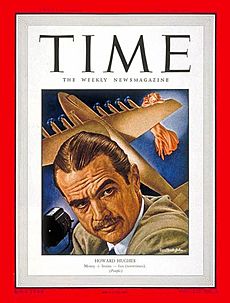
From the 1940s to the late 1950s, the Hughes Tool Company got involved in the film industry. It bought part of the RKO companies. These included RKO Pictures, RKO Studios, a group of movie theaters, and a network of radio stations.
In 1948, Hughes took control of RKO, which was a struggling Hollywood studio. He bought 929,000 shares for $8,825,000. This would be about $107 million today. Within weeks of buying the studio, Hughes fired 700 employees. The number of movies made dropped to 9 in his first year. Before, RKO had made about 30 movies each year.
Hughes stopped movie production at the studio for six months. During this time, he had people investigate the political views of every RKO employee. Hughes would only approve finished movies after making sure the actors under contract had no suspicious connections. This was especially true for the women working for RKO. If Hughes felt his stars did not show the political views he liked, or if a film's anti-communist message was not clear enough, he would stop it.
In 1953, Hughes was part of a big lawsuit. This was part of the settlement of the United States v. Paramount Pictures, Inc. Antitrust Case. Because of these hearings, RKO's unstable situation became very clear. Hughes was getting very annoyed by many lawsuits from RKO's smaller shareholders. They accused him of mismanaging money and the company. Hughes wanted to focus on his aircraft and TWA businesses. So, he offered to buy out all other RKO stockholders to stop the distractions.
By the end of 1954, Hughes had almost complete control of RKO. This cost him nearly $24 million. He became the first single owner of a major Hollywood studio since the silent-film era. Six months later, Hughes sold the studio for $25 million. Hughes kept the rights to movies he had personally produced, including those made at RKO. He also kept Jane Russell's contract. For Howard Hughes, this was almost the end of his 25 years in the movie business. However, his reputation as a financial genius remained strong. During his time, RKO became known for classic film noir movies. This was partly because these films needed small budgets, which fit Hughes's way of running things. Hughes reportedly made $6.5 million in personal profit from RKO.
Real Estate Investments
Howard Hughes Corporation
According to Noah Dietrich, "Land became a main asset for the Hughes empire." Hughes bought 1200 acres in Culver City for Hughes Aircraft. He also bought 7 sections (4,480 acres) in Tucson for his Falcon missile plant. He purchased 25,000 acres near Las Vegas. In 1968, the Hughes Tool Company bought the North Las Vegas Air Terminal.
The Howard Hughes Corporation started in 1972. It was first called Summa Corporation. In 1988, Summa announced plans for Summerlin. This was a large planned community named after Howard Hughes's grandmother, Jean Amelia Summerlin.
Hughes first stayed at the Desert Inn hotel. He refused to leave his room. Instead, he decided to buy the entire hotel. Hughes expanded his financial empire to include Las Vegas land, hotels, and media companies. He spent about $300 million. He used his power to buy many well-known hotels, especially those linked to organized crime. He quickly became one of the most powerful men in Las Vegas. He helped change Las Vegas from its Wild West image into a more refined, modern city. Besides the Desert Inn, Hughes eventually owned the Sands, Frontier, Silver Slipper, Castaways, and Landmark hotels. He also owned Harold's Club in Reno. Hughes eventually became the largest employer in Nevada.
Aviation and Aerospace
Another part of Hughes's business interests was aviation, airlines, and the aerospace and defense industries. Hughes loved airplanes and was a pilot his whole life. He survived four plane accidents. One was in a Thomas-Morse Scout while filming Hell's Angels. Another was while setting the airspeed record in the Hughes Racer. One happened at Lake Mead in 1943. The last was a very bad crash of the Hughes XF-11 in 1946. He learned to fly from early pilots like Moye Stephens. He set many world records. He also had special planes built for himself while leading Hughes Aircraft at the airport in Glendale, California. The most important plane he had built was the Hughes H-1 Racer. On September 13, 1935, Hughes flew the H-1. He set the landplane airspeed record of 352 miles per hour (566 km/h). This was the last time a plane built by a private person set the world airspeed record. A year and a half later, on January 19, 1937, Hughes flew the same H-1 Racer. It had longer wings. He set a new transcontinental airspeed record. He flew non-stop from Los Angeles to Newark in seven hours, 28 minutes, and 25 seconds. This beat his old record of nine hours, 27 minutes. His average speed was 322 miles per hour (518 km/h).
The H-1 Racer had many new design ideas. It had landing gear that could be pulled up into the plane. All the rivets and joints were flat with the plane's body to reduce drag. The H-1 Racer is thought to have influenced the design of many World War II fighter planes. These include the Mitsubishi A6M Zero, Focke-Wulf Fw 190, and F8F Bearcat. In 1975, the H-1 Racer was given to the Smithsonian.
Hughes Aircraft Company
In 1932, Hughes started the Hughes Aircraft Company. It was a part of Hughes Tool Company. He rented a small space in a Lockheed Aircraft Corporation hangar in Burbank, California, to build the H-1 racer.
Soon after starting the company, Hughes used the fake name "Charles Howard." He took a job as a baggage handler for American Airlines. He was quickly promoted to co-pilot. Hughes kept working for American Airlines until his real identity was found out.
During and after World War II, Hughes made his company a major defense contractor. The Hughes Helicopters part of the company started in 1947. This happened when the helicopter maker Kellett sold their newest design to Hughes for production. Hughes Aircraft became a big U.S. aerospace and defense company. It made many technology products. These included spacecraft, military aircraft, radar systems, and the first working laser. They also made aircraft computer systems, missile systems, and commercial satellites.
In 1953, Howard Hughes gave all his stock in the Hughes Aircraft Company to the new Howard Hughes Medical Institute. This made the aerospace and defense company a tax-exempt charity. The Howard Hughes Medical Institute sold Hughes Aircraft in 1985 to General Motors for $5.2 billion.
Around-the-World Flight
On July 14, 1938, Hughes set another record. He flew around the world in just 91 hours (three days, 19 hours, 17 minutes). This beat the old record by almost four days. The previous record was 186 hours (7 days, 18 hours, 49 minutes). He flew a Lockheed 14 Super Electra plane. It had two engines and a crew of four. It also had the newest radio and navigation equipment. Hughes wanted the flight to show how great U.S. aviation technology was. He wanted to prove that safe, long-distance air travel was possible.
When he returned to New York City, he was given a big parade. Hughes and his crew won the 1938 Collier Trophy for their record-breaking flight. He also won the Harmon Trophy in 1936 and 1938 for his flight around the world.
In 1938, the William P. Hobby Airport in Houston, Texas was renamed after Hughes. But the name was changed back because people were upset about naming an airport after a living person. Hughes also helped pay for the Boeing 307 Stratoliner for TWA. He also helped design and pay for the Lockheed L-049 Constellation.
Other awards he received for aviation include the Bibesco Cup in 1938, the Octave Chanute Award in 1940, and a special Congressional Gold Medal in 1939. This medal was given "in recognition of the achievements of Howard Hughes in advancing the science of aviation and thus bringing great credit to his country throughout the world."
Plane Crashes and Inventions
In the spring of 1943, Hughes spent almost a month in Las Vegas. He was testing his Sikorsky S-43 amphibious aircraft. He practiced landing and taking off on Lake Mead. This was to get ready for flying the H-4 Hercules. On May 17, 1943, Hughes flew the Sikorsky from California. He had two aviation inspectors, two of his employees, and actress Ava Gardner with him. Hughes dropped Gardner off in Las Vegas. Then he went to Lake Mead for tests. The test flight did not go well. The Sikorsky crashed into Lake Mead. One inspector and one of Hughes's employees died. Hughes hit his head on the control panel and had a bad cut. Someone else on board had to rescue him. Hughes paid divers $100,000 to get the plane out of the water. He later spent over $500,000 to fix it.
The XF-11 Crash
Hughes was almost killed on July 7, 1946. He was flying the first test flight of the XF-11 near Hughes Airfield in Culver City, California. Hughes flew much longer than the planned 45 minutes. An oil leak caused one of the propellers to reverse direction. This made the plane turn sharply and lose height fast. Hughes tried to land the plane on a golf course. But just before reaching it, the XF-11 dropped quickly. It crashed in the Beverly Hills neighborhood.
When the XF-11 stopped after hitting three houses, the fuel tanks exploded. This set the plane and a nearby home on fire. Hughes managed to get out of the burning wreckage. But he lay next to the plane until he was rescued by U.S. Marine Corps Master Sergeant William L. Durkin. Durkin happened to be visiting friends nearby. Hughes was badly hurt in the crash. He had a broken collar bone, many cracked ribs, and a crushed chest. His left lung collapsed, and his heart moved to the right side of his chest. He also had many third-degree burns. A common story says Hughes sent Durkin money every week for the rest of his life to thank him.
Even with his injuries, Hughes was proud that his mind still worked. While in his hospital bed, he decided he did not like the bed's design. He called in engineers to design a special bed. It had hot and cold running water, was built in six parts, and had 30 electric motors. It could be adjusted with buttons. Hughes designed the bed to help with the pain from his severe burns. He never actually used the bed he designed. His doctors thought his recovery was almost a miracle.
The H-4 Hercules ("Spruce Goose")
The government first hired Henry J. Kaiser and Hughes to build the huge HK-1 Hercules flying boat. It was meant to carry troops and equipment across the Atlantic during World War II. This was an alternative to ships, which German submarines could attack. The military did not want the project. They thought it would take resources from more important programs. But Hughes had powerful friends in Washington, D.C., who supported it. After some disagreements, Kaiser left the project. Hughes decided to continue it as the H-4 Hercules. However, the plane was not finished until after World War II.
The Hercules was the world's largest flying boat. It was the largest aircraft made from wood. At 319 feet 11 inches (97.5 meters), it had the longest wingspan of any aircraft. (The Hercules is no longer the longest or heaviest aircraft ever built. The Antonov An-225 Mriya built in 1985 is bigger.)
The Hercules flew only once, for 1 mile (1.6 km). It flew 70 feet (21 meters) above the water. Hughes was at the controls on November 2, 1947.
Critics called the Hercules the Spruce Goose. But it was actually made mostly from birch wood, not spruce. It was not made from aluminum because the contract said Hughes had to build it from "non-strategic materials." It was built in Hughes's facility in Westchester, California. In 1947, Howard Hughes had to explain to a Senate committee why the H-4 project had so many problems. He also had to explain why $22 million had only produced two prototypes of the XF-11. After being shown at the Long Beach, California, harbor, the Hercules was moved to McMinnville, Oregon. As of 2020, it is on display at the Evergreen Aviation & Space Museum.
Airlines
In 1939, Jack Frye, the president of Transcontinental & Western Airlines (which became Trans World Airlines (TWA)), asked Hughes to buy a majority of TWA stock. Hughes quietly bought 78% of the stock. By 1944, he had control of the airline. Even though he never had an official job at TWA, Hughes chose the board of directors. He often gave orders directly to the airline staff. Hughes Tool Co. bought the first six Stratoliners that Boeing made. Hughes used one himself, and TWA operated the other five.
Hughes is often given credit for the Lockheed Constellation airliner. Hughes and Frye ordered it in 1939. They wanted it to be a long-range replacement for TWA's Boeing 307 Stratoliner fleet. Hughes personally paid for TWA to buy 40 Constellations for $18 million. This was the biggest aircraft order in history at that time. The Constellations were among the best commercial planes of the late 1940s and 1950s. They allowed TWA to start non-stop flights across the country. During World War II, Hughes used his political connections in Washington. He got rights for TWA to fly to Europe. This made TWA the only U.S. airline with both domestic and transatlantic routes.
After the Boeing 707 was announced, Hughes wanted a more advanced jet for TWA. He talked to Convair in late 1954. Convair suggested two ideas to Hughes. But Hughes could not decide which one to choose. Convair eventually stopped its jet project after the designs for the 707 and Douglas DC-8 were shown. Other airlines like United Airlines and American Airlines ordered many 707s. But Hughes only ordered eight 707s through Hughes Tool Company. He also told TWA not to use the aircraft.
In 1960, Hughes was forced out of TWA's management. But he still owned 78% of the company. In 1966, Hughes had to sell his TWA shares. He received $546,549,771 from the sale.
In 1970, Hughes bought Air West, an airline based in San Francisco. He renamed it Hughes Airwest. By the late 1970s, Hughes Airwest flew only jet planes. These included Boeing 727-200 and Douglas DC-9 jets. They flew to many places in the western U.S., Mexico, and western Canada. By 1980, the airline flew to 42 cities. Hughes Airwest was then bought by Republic Airlines (1979–1986) in late 1980.
Howard Hughes Medical Institute
In 1953, Hughes started the Howard Hughes Medical Institute in Miami. Its goal was to do basic biomedical research. Hughes wanted to understand the "genesis of life itself." This was because of his lifelong interest in science and technology. Hughes's first will, which he signed in 1925, said that part of his money should be used to create a medical institute with his name. When a big fight with the IRS (tax agency) was coming, Hughes gave all his stock in the Hughes Aircraft Company to the institute. This made the aerospace and defense company a for-profit part of a charity that did not have to pay taxes.
In 1954, Hughes transferred Hughes Aircraft to the foundation. The foundation paid Hughes Tool Co. $18,000,000 for the assets. The foundation leased the land from Hughes Tool Co. This difference in rent, $2,000,000 per year, became the foundation's money to operate.
This deal led to a long legal battle between Hughes and the Internal Revenue Service. Hughes eventually won. After his death in 1976, many thought that the rest of Hughes's money would go to the institute. But it was divided among his cousins and other family members. This was because there was no will saying otherwise. The HHMI was the fourth largest private organization in 2007. It is one of the largest groups dedicated to biological and medical research.
Glomar Explorer and the K-129 Submarine
In 1972, during the Cold War, the CIA asked Hughes for help. They wanted him to secretly recover the Soviet submarine K-129. It had sunk near Hawaii four years earlier. Hughes's involvement gave the CIA a believable cover story. They said they were doing expensive civilian marine research deep in the ocean. They also claimed to be mining undersea manganese nodules. The recovery plan used a special ship called the Glomar Explorer.
In the summer of 1974, the Glomar Explorer tried to lift the Soviet submarine. However, during the recovery, a mechanical part on the ship broke. This caused half of the submarine to break off and fall back to the ocean floor. This part is believed to have held many of the most wanted items. These included its code book and nuclear missiles. Two nuclear-tipped torpedoes and some code machines were recovered. The bodies of six Soviet submariners were also found. They were later given a formal burial at sea in a filmed ceremony.
The operation, known as Project Azorian, became public in February 1975. This happened after secret documents were released. These documents were obtained by burglars of Hughes's headquarters in June 1974. Even though Hughes lent his name and company resources, he and his companies were not actively involved in the project. The Glomar Explorer was later bought by Transocean. It was sent to the scrap yard in 2015.
Personal Life
Early Marriage
In 1929, Hughes's wife of four years, Ella, went back to Houston. She filed for divorce.
Later Marriage to Jean Peters
On January 12, 1957, Hughes married actress Jean Peters. They had a small wedding in Tonopah, Nevada. The couple had met in the 1940s, before Peters became a movie actress. They had a very public romance in 1947. There was talk of marriage, but she said she could not combine it with her career. Some people later said that Peters was "the only woman [Hughes] ever loved." He reportedly had his security guards follow her everywhere, even when they were not dating.
In 1970, Jean Peters filed for divorce. The two had not lived together for many years. Peters asked for a lifetime payment of $70,000 a year, adjusted for inflation. She gave up all claims to Hughes's estate. Hughes offered her over a million dollars, but she said no. Hughes did not make her sign a confidentiality agreement as part of the divorce. His aides said that Hughes never spoke badly about her. She refused to talk about her life with Hughes. She turned down many offers from publishers and writers. Peters would only say that she had not seen Hughes for several years before their divorce. She had only talked to him by phone.
Last Years
Health Challenges
Hughes was widely seen as unusual. He suffered from severe obsessive-compulsive disorder (OCD).
His business partner, Noah Dietrich, wrote that Hughes always ate the same thing for dinner. It was a New York strip steak cooked medium rare, a dinner salad, and peas. But he would only eat the smaller peas, pushing the larger ones aside. For breakfast, he wanted his eggs cooked exactly how his family cook, Lily, made them. Hughes had a strong fear of germs. His need for secrecy became very intense.
In 1958, Hughes told his helpers that he wanted to watch some movies at a film studio near his home. He stayed in the studio's dark screening room for more than four months. He never left. He ate only chocolate bars and chicken. He drank only milk. He was surrounded by many boxes of Kleenex that he constantly stacked and moved around. He wrote detailed notes to his helpers. He told them not to look at him or talk to him unless he spoke first. During this time, Hughes sat in his chair, always watching movies. When he finally came out in the summer of 1958, his hygiene was very bad. He had not bathed or cut his hair and nails for weeks. This might have been because of allodynia. This condition causes pain from things that usually do not hurt.
After the screening room incident, Hughes moved into a bungalow at the Beverly Hills Hotel. He also rented rooms there for his helpers, his wife, and many girlfriends. He would sit in his bedroom, watching movies. He may have watched movies to distract himself from his pain. This is common for people with constant pain, especially if they do not get enough treatment. In one year, he spent about $11 million at the hotel.
Hughes became obsessed with the 1968 film Ice Station Zebra. He had it played over and over in his home. His helpers said he watched it 150 times. He felt bad about his film The Conqueror not doing well. So he bought every copy of the film for $12 million. He watched the film repeatedly.
Hughes insisted on using tissues to pick up objects. This was to protect himself from germs. He would also notice dust or stains on people's clothes. He would demand that they clean them. Hughes, once one of the most public figures in America, eventually disappeared from public view. But newspapers still reported rumors about him. People said he was very sick, mentally unstable, or even dead.
Injuries from his many plane crashes caused Hughes to be in pain for much of his later life. He had his hair cut and nails trimmed only once a year. This was likely due to the pain from a condition called RSD/CRPS, caused by the plane crashes.
Later Years in Las Vegas
The rich and aging Hughes, with his personal helpers, started moving from one hotel to another. He always stayed in the top floor penthouse. In the last ten years of his life (1966 to 1976), Hughes lived in hotels in many cities. These included Beverly Hills, Boston, Las Vegas, Nassau, Freeport, and Vancouver.
On November 24, 1966, Hughes arrived in Las Vegas by train. He moved into the Desert Inn. He refused to leave the hotel. To avoid more problems with the owners, Hughes bought the Desert Inn in early 1967. The hotel's eighth floor became the center of Hughes's business empire. The ninth-floor penthouse became his personal home. Between 1966 and 1968, he bought several other hotel-casinos. These included the Castaways, New Frontier, the Landmark Hotel and Casino, and the Sands. He bought the small Silver Slipper casino just to move its famous neon silver slipper sign. The sign was visible from his bedroom and had apparently kept him awake at night. After Hughes left the Desert Inn, hotel employees found that his drapes had not been opened the whole time he lived there and had rotted.
Hughes wanted to make Las Vegas seem more glamorous. He wrote in a note to a helper, "I like to think of Las Vegas in terms of a well-dressed man in a dinner jacket and a beautifully jeweled and furred female getting out of an expensive car." Hughes bought several local television stations.
As an owner of several major Las Vegas businesses, Hughes had a lot of political and economic power in Nevada and other places. During the 1960s and early 1970s, he did not approve of underground nuclear testing at the Nevada Test Site. Hughes was worried about the risk from nuclear radiation. He tried to stop the tests. When the tests happened anyway, the explosions were so strong that the entire hotel where he lived shook from the shock waves. In two separate, last-minute attempts, Hughes told his representatives to offer $1 million to both Presidents Lyndon B. Johnson and Richard Nixon.
In December 1972, Hughes was living in the Intercontinental Hotel near Lake Managua in Nicaragua. He was looking for privacy and safety. A magnitude 6.5 earthquake damaged Managua. As a safety measure, Hughes moved to a large tent facing the hotel. After a few days, he moved to the Nicaraguan National Palace. He stayed there as a guest of Anastasio Somoza Debayle. The next day, he left for Florida on a private jet. He then moved into the penthouse at the Xanadu Princess Resort on Grand Bahama Island, which he had recently bought. He lived almost only in the penthouse of the Xanadu Beach Resort & Marina for the last four years of his life. Hughes spent a total of $300 million on his many properties in Las Vegas.
Autobiography Hoax
In 1972, author Clifford Irving caused a big stir in the media. He claimed he had co-written an authorized autobiography of Hughes. Irving said he and Hughes had sent letters to each other. He showed handwritten notes that he said were from Hughes as proof. The publisher, McGraw-Hill, Inc., was tricked into believing the book was real. Hughes was so private that he did not immediately deny Irving's statement in public. This made many people believe Irving's book was real. However, before the book was published, Hughes finally spoke out against Irving. He did this in a teleconference with reporters he knew personally.
The whole trick eventually fell apart. The United States Postal Inspection Service got a court order. This forced Irving to give samples of his handwriting. The investigation led to Irving being charged and later found guilty of using the postal service to commit fraud. He was put in jail for 17 months. The 2006 film The Hoax, starring Richard Gere, is based on these events.
Death
Hughes is reported to have died on April 5, 1976, at 1:27 p.m. He was on board a Learjet 24B N855W plane. He was flying from his penthouse at the Acapulco Princess Hotel in Mexico to the Methodist Hospital in Houston.
Hughes is buried next to his parents at Glenwood Cemetery in Houston.
His Estate
About three weeks after Hughes died, a handwritten will was found. It was on the desk of an official of the Church of Jesus Christ of Latter-day Saints in Salt Lake City, Utah. This "Mormon Will" gave $1.56 billion to different charities. This included $625 million to the Howard Hughes Medical Institute. It also gave almost $470 million to the top managers in Hughes's companies and to his helpers. It gave $156 million to his first cousin, William Lummis. And it split $156 million equally between his two ex-wives, Ella Rice and Jean Peters.
Another $156 million was given to a gas station owner, Melvin Dummar. Dummar told reporters that in 1967, he found a messy and dirty man lying along U.S. Route 95. This was about 150 miles (240 km) north of Las Vegas. The man asked for a ride to Vegas. Dummar said the man told him he was Hughes when he dropped him off at the Sands Hotel. Dummar later claimed that days after Hughes died, a "mysterious man" appeared at his gas station. This man left an envelope with the will on his desk. Dummar was not sure if the will was real. He left it at the LDS Church office. In 1978, a Nevada court said the Mormon Will was fake. It officially declared that Hughes had died intestate (without a valid will). Dummar's story was later made into Jonathan Demme's film Melvin and Howard in 1980.
Hughes's $2.5 billion estate was eventually split in 1983 among 22 cousins. This included William Lummis, who works as a trustee of the Howard Hughes Medical Institute. The Supreme Court of the United States ruled that Hughes Aircraft was owned by the Howard Hughes Medical Institute. The institute sold it to General Motors in 1985 for $5.2 billion.
Awards and Recognition
- Harmon Trophy (1936 and 1938)
- Collier Trophy (1938)
- Congressional Gold Medal (1939)
- Octave Chanute Award (1940)
- National Aviation Hall of Fame (1973)
- International Air & Space Hall of Fame (1987)
- Motorsports Hall of Fame of America (2018)
Filmography
| Year | Title | Director | Producer | Writer |
|---|---|---|---|---|
| 1927 | Two Arabian Knights | No | Yes | No |
| 1930 | Hell's Angels | Yes | Yes | No |
| 1931 | The Front Page | No | Yes | No |
| 1932 | Sky Devils | No | Yes | No |
| Scarface | No | Yes | No | |
| 1943 | The Outlaw | Yes | Yes | No |
| Behind the Rising Sun | No | Yes | No | |
| 1947 | The Sin of Harold Diddlebock | No | Uncredited | No |
| 1950 | Vendetta | No | Yes | No |
| 1951 | His Kind of Woman | No | Executive | Uncredited |
| 1952 | Macao | No | Yes | No |
| 1955 | Son of Sinbad | No | Executive | No |
| 1956 | The Conqueror | No | Yes | No |
| 1957 | Jet Pilot | No | Yes | No |
Images for kids
See also
 In Spanish: Howard Hughes para niños
In Spanish: Howard Hughes para niños
- List of richest Americans in history
- List of wealthiest historical figures
- List of aviation pioneers
- List of entrepreneurs


